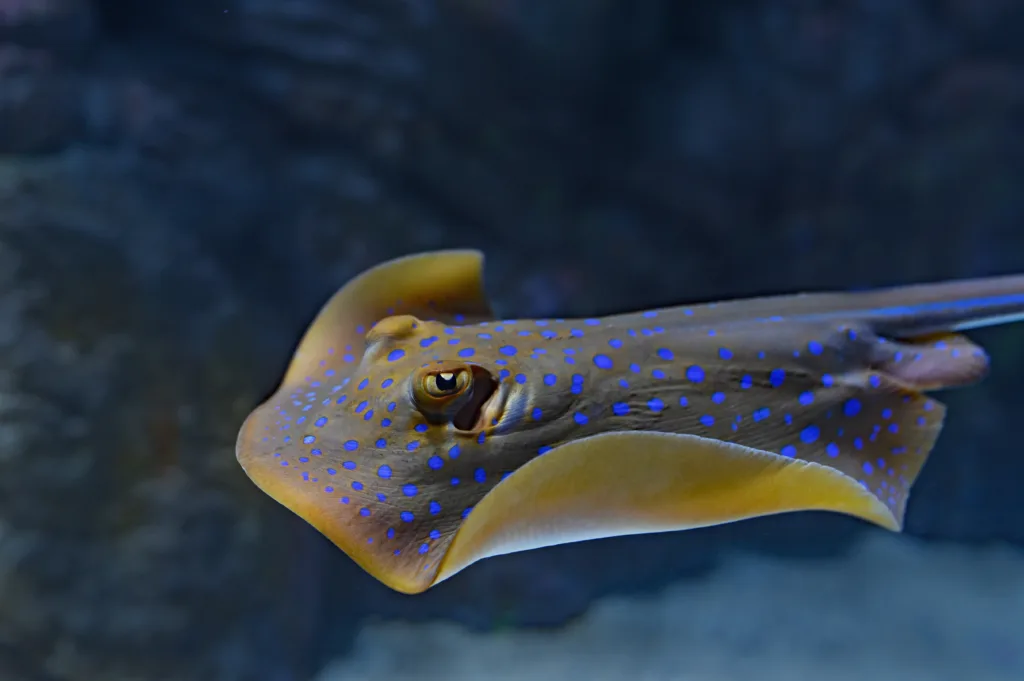Stingrays are fascinating creatures that can be found in oceans all over the world. They are known for their unique ability to sting, which can be very painful and even deadly for humans. But how do stingrays actually sting?
Firstly, it is important to understand that stingrays have a stinger located at the base of their tail. This stinger is made up of a hard, sharp spine that is coated in a venomous mucus. When a stingray feels threatened or attacked, it will whip its tail around to strike its attacker with the stinger.
The stinger itslf is not actually a barb, as some people might believe. Instead, it is more like a jagged knife blade with reverse-serrated edges. This design allows the stinger to easily penetrate the skin of its target, while also making it difficult to remove.
When the stinger pierces the skin, it causes a bleeding wound that can become swollen, red or blue. It also delivers a dose of venom into the victim’s body, which can cause a range of symptoms depending on the severity of the sting.
It is worth noting that stingrays are not typically aggressive animals. They will generally only sting humans if they feel threatened or provoked in some way. In fact, most stingray stings occur when a person accidentally steps on a stingray that is hiding in the sand.
If you are stung by a stingray, it is important to seek medical attention as soon as possible. The wound should be thoroughly cleaned and treated to prevent infection, and any symptoms should be closely monitored. In severe cases, stingray stings can cause muscle cramps, paralysis, seizures, and even death.
Stingrays sting by using their stinger, which is located at the base of their tail. When threatened, they whip their tail around to strike their attacker with the stinger, which is like a jagged knife blade with reverse-serrated edges. Stingray stings can be very painful and even deadly, so it is important to exercise caution around these beautiful creatures.
The Pain of a Stingray Sting
Stingray stings are known to be incredibly painful. The sting itself causes a bleeding wound that may become swollen and turn blue or red. The pain can be excruciating and may last for several hours or even days. The severity of the pain can depend on the location of the sting and the individual’s tolerance for pain.
In addition to the pain, other symptoms may also occur. These can include nausea, fever, muscle cramps, paralysis, elevated heart rate, and seizures. In some cases, the sting can even lead to death.
It’s important to seek medical attention immediately after beig stung by a stingray. Treatment may include soaking the affected area in hot water to help alleviate the pain and prevent infection. Antibiotics and tetanus shots may also be necessary.
To avoid getting stung by a stingray, it’s recommended to shuffle your feet when walking in shallow water to avoid stepping on one. If you do happen to get stung, it’s important to stay calm and seek medical attention as soon as possible.

Surviving a Stingray Sting
Stingray stings can be painful and potentially dangerous, but most people who experience a stingray sting recover completely. However, in rare cases, stingray stings can be life-threatening.
Surviving a stingray sting depends on various factors, including the location of the sting, the amount of venom injected, and the health of the person stung. In general, if the sting is on a limb or extremity, the prognosis is better than if the sting is on the torso or abdomen.
The initial treatment for a stingray sting is to wash the wound thoroughly with soap and water. Immersing the affected area in hot water (as hot as the person can tolerate) for 30-90 minutes can also help alleviate pain and neutralize the venom. However, it is essential to seek medical care as soon as possible, as the wound may require furher treatment, such as antibiotics, tetanus vaccine, or even surgery.
Stingray stings can cause various complications, such as infection, nerve damage, and allergic reactions. If left untreated, these complications can be severe and even life-threatening. Therefore, it is crucial to seek medical attention promptly.
Although stingray stings can be painful and potentially dangerous, most people who experience a stingray sting can survive with prompt medical care. If you get stung by a stingray, wash the wound thoroughly, immerse the affected area in hot water, and seek medical care as soon as possible.
Do Stingrays Sting or Cause Injury?
Stingrays are known for ther unique defense mechanism, which involves using their serrated tail spine to inflict injury on predators or perceived threats. While the term “sting” is often used to describe this action, it’s actually more accurate to say that stingrays stab their victims.
The spine of a stingray is not like a traditional stinger, such as those found on bees or wasps. Instead, it’s more like a sharp, pointed blade with reverse-serrated edges. When the stingray feels threatened, it will whip its tail around and use its spine to slash at whatever is causing it to feel threatened.
The results of a stingray attack can be quite serious, as the spine can cause deep lacerations and even puncture vital organs. In some cases, the venom present in the spine can also cause intense pain, muscle cramps, and other symptoms.
It’s important to note that stingrays are not naturally aggressive towards humans and typically only use their spine in self-defense. However, accidental encounters can occur, especially when people are wading in shallow water where stingrays may be present.
To avoid being stabbed by a stingray, it’s important to be aware of your surroundings when swimming or wading in shallow water. Avoid stepping on or disturbing stingrays, and shuffle your feet along the bottom to avoid accidentally stepping on one. If you do happen to be stung by a stingray, seek medical attention immediately to properly treat the wound and any potential venom exposure.
The Effects of Stingray Attacks
Stingrays are generally knon to be peaceful creatures, and they do not attack humans or other animals unless provoked. However, when threatened or stepped on, they may respond by using their stinger, which is located in their tail. The stinger is a sharp, barbed spine that can cause a painful injury or even death.
When a stingray attacks, it whips its tail upward, and the stinger is thrust forward. The stinger is covered in a venomous slime that can cause intense pain, swelling, and even paralysis. In some cases, the venom can be fatal.
Stingrays usually use their stingers as a defensive mechanism rather than an offensive one. They typically don’t actively seek out prey or attack other animals unless they feel threatened. Their primary reaction to danger is to swim away quickly.
It’s important to note that stingrays are not aggressive animals and will generally avoid humans and other animals unless they feel threatened. If you encounter a stingray in the wild, it’s best to keep your distance and avoid touching it. If you do get stung, seek medical attention immediately to prevent further complications.

Conclusion
Stingrays sting by using their stinger, which is located at the base of their tail. When threatened, the stingray will whip up its tail and sting with a mini knife blade that has reverse-serrated edges. This can cause excruciating pain, swelling, and even serious infection or allergic reactions in some cases. While stingrays generally do not attack aggressively or actively defend themselves, it is important to be cautious and avoid stepping on or disturbing them in their natural habitat. If you do happen to get stung by a stingray, it is important to wash the wound immediatey and seek medical care as soon as possible. By understanding how stingrays sting and taking the necessary precautions, we can better protect ourselves and these fascinating creatures.
